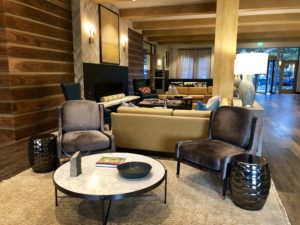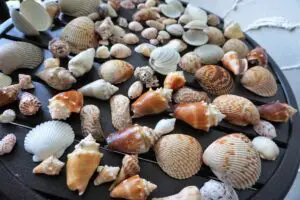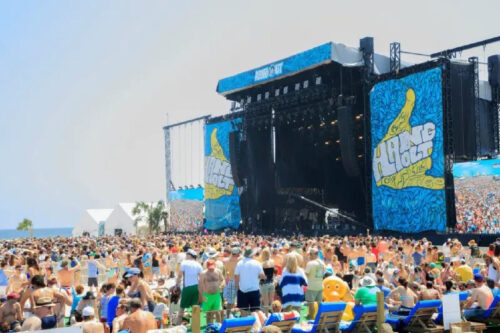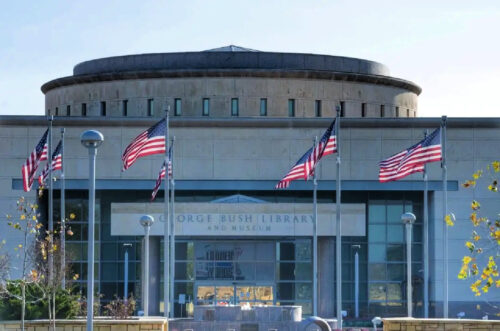There are a quartet of museums that tell Baton Rouge, Louisiana’s story from all sides.
Old State Capitol Museum
Louisiana’s Old State Capital Museum in the building that served as the capital until the Huey Long era will bring you up to date on Louisiana’s complex politics. The film, The Ghost of the Castle, is a 4D immersive experience created by one of the Disney artists. It tells the story through the eyes of Sara Morgan, a Baton Rouge lady who loved the beautiful old castle/capital.
The museum is worth a visit for the architectural splendor and the stained glass dome is a one-of-a-kind beauty. However it also outlines Louisiana politics. And believe me as someone who grew up in Louisiana, no fiction writer could create those characters like Governor, Senator, and presidential candidate Huey Long, Governor Earl Long, Governor Edwin Edwards, and their kind.
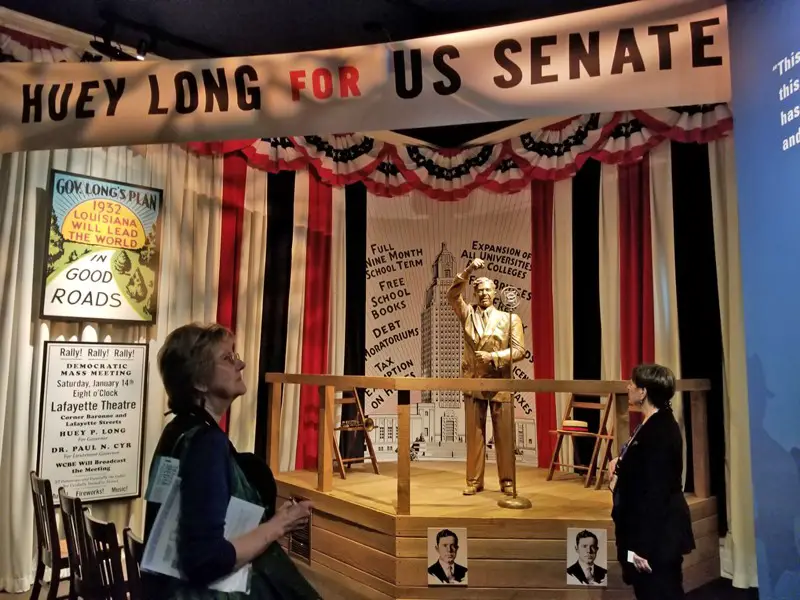
The museum tells of Huey’s rise and later assassination. There are some of Earl’s escapades. And no one will forget Governor Edwards who brought casinos to Louisiana even though gambling is forbidden by Louisiana’s constitution. He merely changed the name to gaming and behold, shiny casinos all over the state.
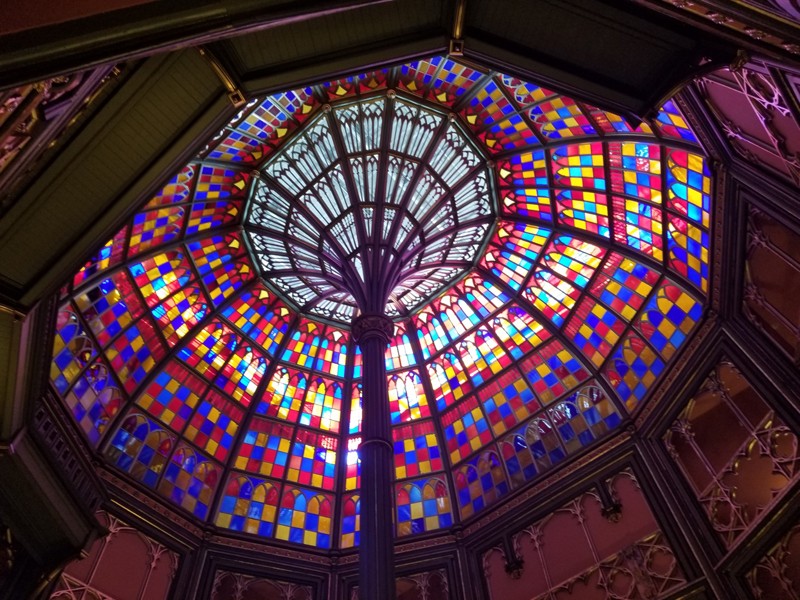
Capitol Park Museum
Capitol Park Museum opened in 2006 just after Katrina so it is the most modern of the museums with lots of interactive exhibits. It appeals to kids as well as adults. It really covers Louisiana’s colorful history from the days of the Louisiana Purchase to present. Food is big in Louisiana’s culture. At one of the first exhibits, you are greeted by a giant crawfish peeping over a postcard from Louisiana at the exhibit entrance.
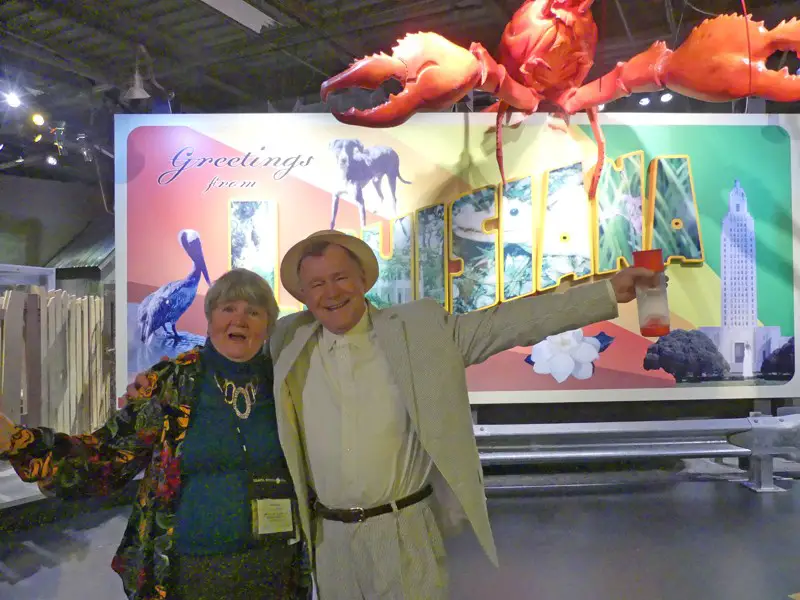
Music that played a big part in Louisiana’s history is well represented from Jazz, Blues, Zydeco, Cajun, Country and Rock and Roll. There are instrument and clothing from people like Louis Armstrong and Fats Domino.
Huey Long was one of the most memorable politicians ever. There is an exhibit where you can decide if you loved or hated the Kingfish as he was called.
Naturally, waterways played a big part in Louisiana history. The Mississippi River is showcased. The giant steamboat exhibit is so realistic. There are pirogues, Native American dugouts, and even a Confederate submarine.
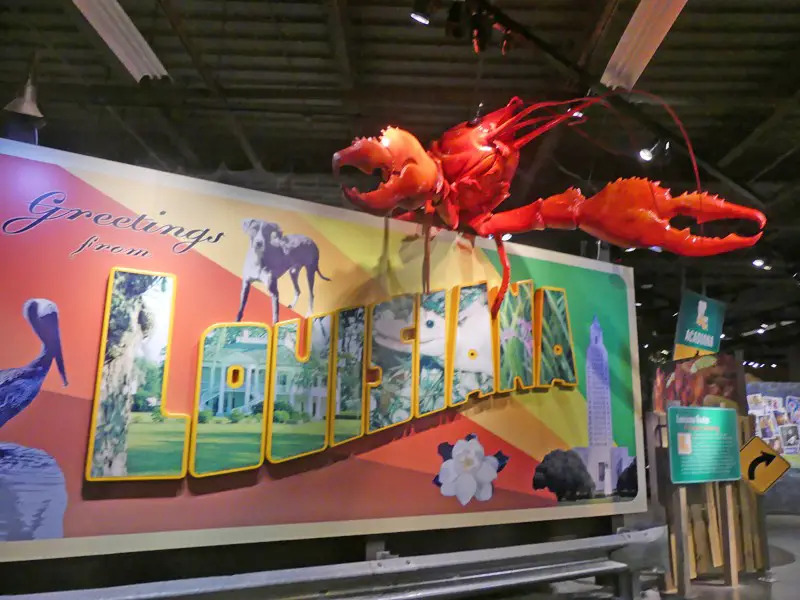
Mardi Gras
Mardi Gras is represented here with all its versions. You’ll see elaborate costumes worn by kings and queens of the different krewes and some floats in the New Orleans version of Mardi Gras and get to meet the Mardi Gras Indians and learn about that African American tradition.
You’ll also learn about the Courir de Mardi Gras, the way Mardi Gras is celebrated in rural Cajun areas. Simply costumed horsemen parade around the community in the morning seeking donations of chicken, sausage, vegetables and rice to make gumbo for a neighborhood celebration in the afternoon. People who donate are rewarded with music and dancing by the riders playing Cajun and Zydeco music.
There are exhibits showing the many different styles of Louisiana homes from plantation homes to a simple shotgun home like you see in New Orleans.

West Baton Rouge Museum
Cotton wasn’t Louisiana’s only staple crop. Sugar cane was equally important in the Baton Rouge area. West Baton Rouge Museum tells the story of Louisiana’s sugar cane industry. A visit to the museum and the historical buildings that make up its campus is a tour through time beginning with the people of the Plaquemines Culture around 1200 to 1400 AD. The story moves to the Choctaw who first encountered European explorers like DeSoto, LaSalle, and Iberville.
It tells of those who came here willingly and those with no choice. The earliest French trappers then French settlers arrived. After the French and Indian War in 1763 it became Spanish property. The Spanish awarded land grants to those who would protect the Mississippi River levee, clear the land, and plant crops for ten years. Acadians, driven from their homeland in Canada, took advantage of that offer.
The exhibits inside and out take you up to the struggle for Civil Rights. Start with the video shown in a room built with tin from one of the last operating local sugar cane mills, Cinclare Mill.

As sugar became an important crop you follow its history viewing a 22 foot model of a mechanical sugar mill built in 1904. Learn about Norbert Rillieux, who invented chemical engineering but because he was half Black, he was not properly credited.
Step outside and visit the other buildings that comprise the museum. The Aillet House was the home of a middle class Louisiana French Creole family. Built as the home of Arcadian sugar plantation owner, Jean Dorville Landry it was bought by the Aillet family who lived in it for over 100 years. Here you see Louisiana’s earliest 1830s French Creole architectural tradition.
Tales of the Buildings
Arbroth General Store tells of Louisiana life between the two world wars. Built in the 1880s, it was originally used as a grocery store and post office at Arbroth Plantation which closed in the 1980s. During Reconstruction, sharecropping workers were paid in script only useable in the plantation store. So convenient as the owners of the plantation also owned the store and could set the prices.
Next you visit Reed Shotgun House, built around 1938 by Joe Reed, owner of a small cattle ranch, for one of his workers who lived there until about 1945.For those not familiar with this style house, it’s a house one room wide with no hall and was popular in Louisiana before the time of indoor bathrooms. You could open front and back doors and fire a shotgun through without hitting anything in-between.
The large red barn is filled with the machinery and tractors used on early plantations.
The Allendale Plantation Cabins are a series of three Cabins that tell the story of the sugar cane workers from slavery through Civil Rights era. The cabins were originally built before the Civil War to house the slaves of Henry Watkins Allen, the last Confederate governor of Louisiana and for whom Port Allen was named.
There’s the Slave Cabin built around 1850. A simple dwelling that housed usually two families. Then the Reconstruction Era Cabin built around 1870. Often former enslaved people remained on the plantations still doing the tasks they had previously but this time getting paid or working as a sharecropper. The third cabin is the Civil Rights Era Cabin, a 20th century Civil Rights field worker’s cabin dated to 1960s.
Last and most fun building is the Juke Joint. It tells the story of how plantation and mill workers let off steam with music and drink. The Blues have a history here. Across the river in Baton Rouge there were Blue Laws requiring bars to close at midnight on Saturday. People crossed the river to West Baton Rouge Parish where things were livelier and bars stayed open all night here.
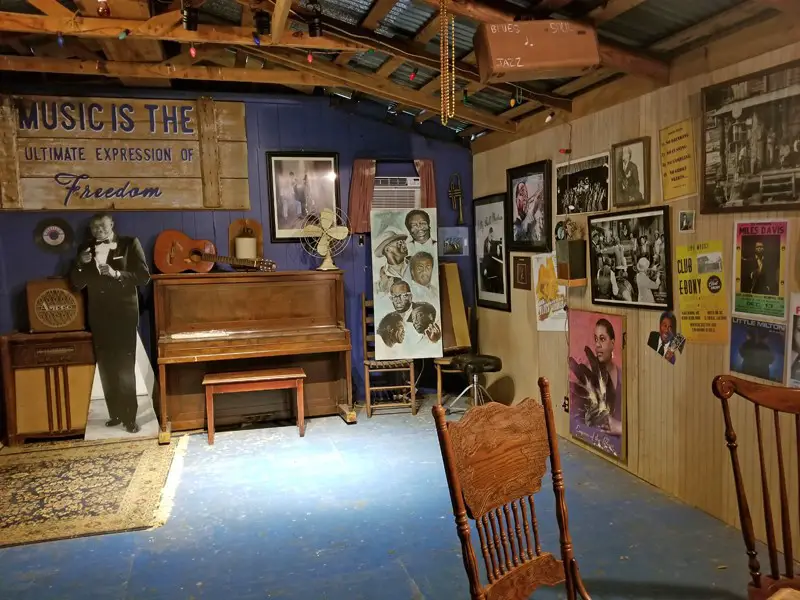
Rural Life Museum
The Rural Life Museum is owned and operated by Louisiana State University (LSU). It’s a combination indoor museum with real items from early Louisiana life and a huge outdoor area devoted to plantation life in Louisiana. It shows the different lifestyle around the state with several authentic building from earlier eras. You enter through the Exhibit Barn filled with artifacts that were part of life in the area. There are vehicles from horse and buggy and wagons to early automobiles. Exhibits explain every facet of life on a plantation in rural Louisiana.
You’ll find a controversial stature there (unless it has been removed by demonstrators in the past few months.) It seems poor Uncle Jack has been protested against and praised a lot over his lifetime. Uncle Jack is a bronze of an elderly, African-American man tipping his hat. Jackson Lee Bryan, a wealthy Natchitoches businessman commissioned the statue in 1926 and dedicated it in recognition of the part African-American slaves played in the building of Louisiana.

The plaque read “in grateful recognition of the arduous and faithful service of the good darkies of Louisiana.” national media proclaimed the statue as a progressive symbol of the New South. Then in the 1960’s African Americans saw Uncle Jack as a symbol of servitude and wanted it removed.
Finally Natchitoches removed Uncle Jack in the middle of the night in 1968 to avoid addition racial unrest. In 1972, Uncle Jack was donated to LSU. For years he stood outside the Rural Life Museum until 2009 when once again protests caused the university to move the statue inside the museum. Only time will tell where Uncle Jack will end up and how he will be seen.
A Historic Plantation
Outside you’ll find the Plantation Area with the home and the outbuildings that comprised the original Windrush Plantation. The home was built by John Charles Burden in 1850. In the day, a plantation was a small village, completely self contained. You’ll find that here with a blacksmith shop, schoolhouse, general store called a commissary, a pigeon coop, a community well, a chicken house, an outhouse, corn crib, grist mill, a church and even a little jail in case people didn’t pay enough attention to what was taught in church.
Plan on lots of extra time as you will spend more time exploring each of these treasures far longer than planned originally.
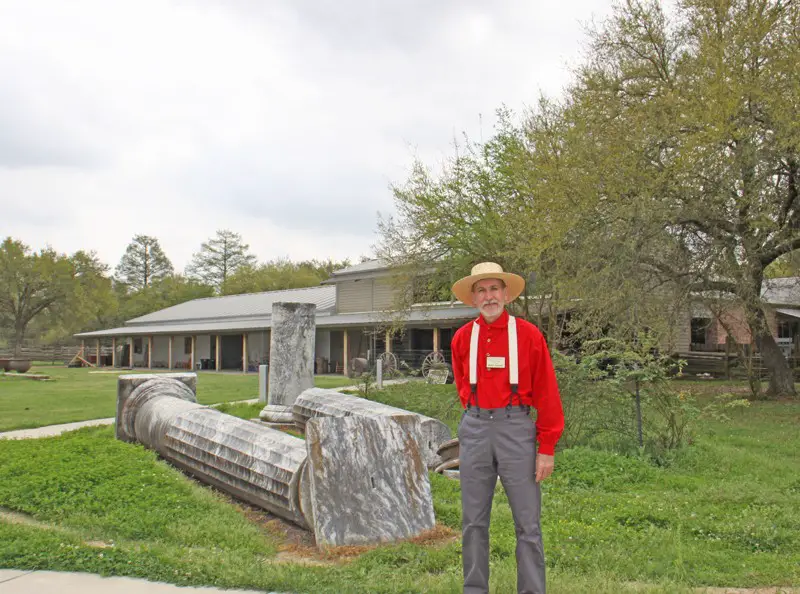
These museums were visited on a Travel South trip and hosted by the Baton Rouge CVB and West Baton Rouge CVB. Opinions are unbiased and original.
Article written by Kathleen Walls of American Roads and Global Highways.
Pin This Post For Later!
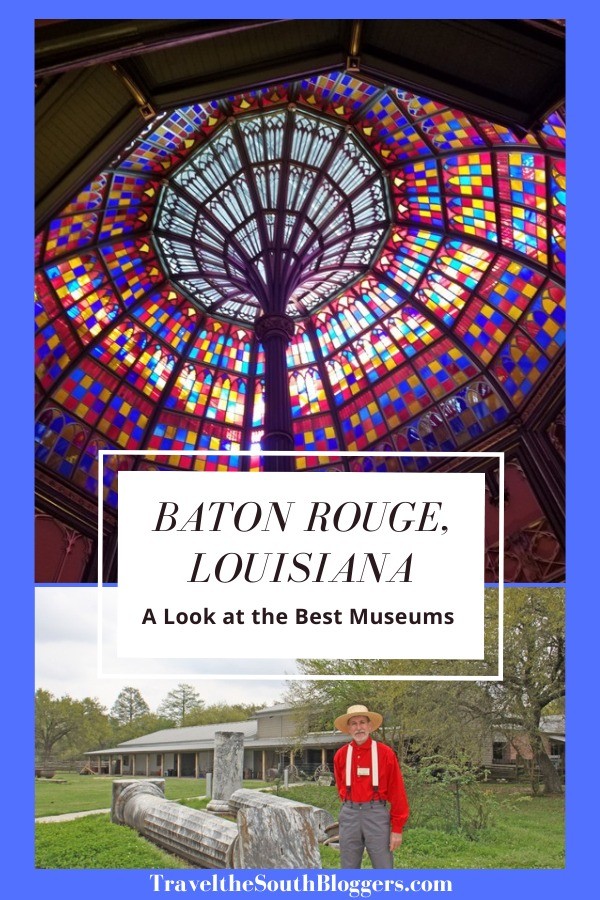
Read more of our Louisiana posts at:
10 New Orleans Treasures Most Visitors Miss


